Good morning, Lon.
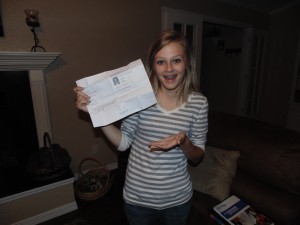 Alert all the local and regional safety agencies. Sound the alarm and post the warnings. The state of Texas has granted Valerie a driver license. On Friday morning, our Little Middle parallel parked like a champ and then aced the driving test, nailing it with a 96. So, consider carefully this advice: be extra cautious around the southwest part of town and, in the early evenings. between here and Canyon.
Alert all the local and regional safety agencies. Sound the alarm and post the warnings. The state of Texas has granted Valerie a driver license. On Friday morning, our Little Middle parallel parked like a champ and then aced the driving test, nailing it with a 96. So, consider carefully this advice: be extra cautious around the southwest part of town and, in the early evenings. between here and Canyon.
Congratulations, Valerie. Now, can you run to the store and get some bread and more Diet Dr Pepper?
~~~~~~~~~~~~~~~~~~~~~
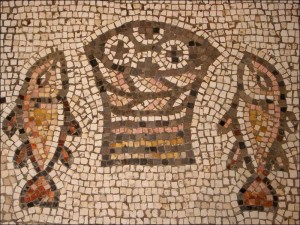 After two weeks of intense Old Testament study concerning the covenant between God and man, the history and nature of covenant meals, the fellowship sacrifices and meals, the presence of God at those meals, and the great joy commanded and experienced around those tables, our Wednesday night Bible class in Sneed Hall has crossed the threshold into the New Testament and the ministry meals of our Lord Jesus. It’s a class on the Lord’s Supper, yet I think most everyone is surprised at how much we explored before we ever got to the Gospels. Well, we had to.
After two weeks of intense Old Testament study concerning the covenant between God and man, the history and nature of covenant meals, the fellowship sacrifices and meals, the presence of God at those meals, and the great joy commanded and experienced around those tables, our Wednesday night Bible class in Sneed Hall has crossed the threshold into the New Testament and the ministry meals of our Lord Jesus. It’s a class on the Lord’s Supper, yet I think most everyone is surprised at how much we explored before we ever got to the Gospels. Well, we had to.
God comes to us in the person of Jesus as a fulfillment of the covenant: “I will make my dwelling place with you; you will be my people and I will be your God.” Emmanuel means “God with us.” And that’s just what/who Jesus is: God with us. God in Christ comes here to dwell among us (“The Word became flesh and made his dwelling among us…” John 1:14). He came to earth to reveal himself to us in Jesus (“Anyone who has seen me has seen the Father.” John 14:9). And God put on our flesh and came to this planet in order to eat and drink with us, to commune with us, around a table.
“I confer on you a Kingdom, just as my Father conferred one on me, so that you may eat and drink at my table in my Kingdom.” ~Luke 22:29-30
“Many will come from the east and the west and will take their places at the feast with Abraham, Isaac, and Jacob in the Kingdom of Heaven.” ~Matthew 8:11
“The Kingdom of Heaven is like a king who prepared a wedding banquet…” ~Matthew 22:2
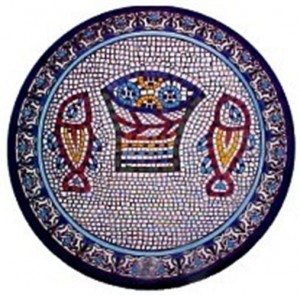 You don’t have to read too far in the Gospels and you don’t have to pay too close attention to see that meals, eating and drinking with people, are the focal point of Jesus’ ministry. Jesus eats with his disciples and with his enemies, with the “righteous” and the “sinners,” with crowds of Jews and crowds of Gentiles, with tax collectors and prostitutes, with Mary and Martha and teachers of the Law. Jesus ate and drank with everybody. He was eating and drinking all the time, so much so that he was accused on several occasions of being a drunkard and a glutton.
You don’t have to read too far in the Gospels and you don’t have to pay too close attention to see that meals, eating and drinking with people, are the focal point of Jesus’ ministry. Jesus eats with his disciples and with his enemies, with the “righteous” and the “sinners,” with crowds of Jews and crowds of Gentiles, with tax collectors and prostitutes, with Mary and Martha and teachers of the Law. Jesus ate and drank with everybody. He was eating and drinking all the time, so much so that he was accused on several occasions of being a drunkard and a glutton.
And in all these Jesus stories, the meals are critically important. They reveal great truths about what God is doing through Jesus in the world. The meals teach lessons about what it means to live as citizens in God’s Kingdom. They express forgiveness and healing, they celebrate restoration and fellowship.
Jesus is eating with Levi and the other tax collectors, showing us in visible ways that the invitation to enjoy fellowship with God is open to all. He’s criticized for his choice in dinner companions and answers by proclaiming that “It is not the healthy who need a doctor, but the sick. I have not come to call the righteous, but sinners!” (Luke 5:31) You get the same thing with Zacchaeus. “The Son of Man came to seek and to save what was lost.” (Luke 19:10)
Jesus forgives the sins of the prostitute at the dinner at the Pharisee’s house in Luke 7. He teaches on hypocrisy and taking care of the poor during the meal with the Pharisees and teachers in Luke 11. At the supper with the Pharisee in Luke 14, our Lord declares again that he’s here to eat with everybody: “Bring in the poor, the crippled, the blind, and the lame!” (Luke 14:21)
Aside from the last dinner with his disciples and the post-resurrection meals, the most important meals during Jesus’ ministry came at the feeding of the multitudes. All four Gospels go to great lengths to report on the miraculous feedings of the five thousand Jews and the four thousand Gentiles. The imagery is unmistakably Messianic. Here’s this great prophet of God providing food for God’s people in the desert. They eat until they are full. Baskets of leftovers are collected. This fulfills Moses. This fulfills prophesy. This is the Anointed One, the Christ!
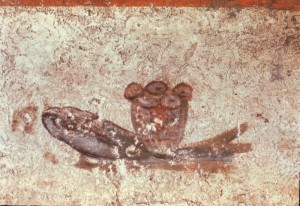 The early church made a pretty big deal about the feeding of the multitudes. The first churches ate their communion meals in the context of these feedings and the truths those stories revealed. It’s why the earliest communion art we have contains images of fish with the bread and the wine. The connections were made not just by the common themes and the prophesies, but by the deliberate wording the New Testament writers used to relate these important meals. They tied the church’s meals to the last supper, the post-resurrection dinners, and the feedings of the crowds with the four-fold liturgy of “take, bless, break, and give.”
The early church made a pretty big deal about the feeding of the multitudes. The first churches ate their communion meals in the context of these feedings and the truths those stories revealed. It’s why the earliest communion art we have contains images of fish with the bread and the wine. The connections were made not just by the common themes and the prophesies, but by the deliberate wording the New Testament writers used to relate these important meals. They tied the church’s meals to the last supper, the post-resurrection dinners, and the feedings of the crowds with the four-fold liturgy of “take, bless, break, and give.”
In every account of these miraculous feedings, Jesus is said to “take” the bread, “bless” it, “break” it, and then “give” it to the disciples. Look it up; it’s in every passage (Luke 9:16, Matthew 14:19, Mark 6:41, Mark 8:6, Matthew 15:36). The same language is even used for the fish in John 6:11. Interestingly, the exact same formula is used in the Last Supper accounts. Jesus takes, breaks, blesses, and gives (Luke 22:19, Mark 14:22, Matthew 26:26). The same four words are used in the same order in the stories of Jesus’ post-resurrection meals, too, tying together all the meals Jesus ate during his ministry to the meals the church was sharing together at the time the stories were recorded. Everything that was going on in those meals — the teachings, the revealed truths, the fellowship and thanksgiving, the invitation and celebration, the anticipation of the final heavenly feast — is also going on today in our church’s meals.
They are all Kingdom meals. The feedings of the crowds, the last dinner, the post-resurrection suppers — they are all Kingdom meals, eaten in community, in the presence of the Lord, with great joy. They each anticipate the fullness of the Messianic banquet in the new heaven and new earth. They’re each characterized by joyful celebration and an abundance of food. To eat with Jesus (God) is to experience and celebrate redemption and acceptance. All the meals proclaim that the Day of great joy for all the people has dawned.
With this understanding, how in the world would the first Christians eat the “Lord’s Supper” in a quiet, somber, individualistic way? How would they imitate or recreate the Lord’s meal with little crumbs of cracker and tiny sips of juice?
Of course, they didn’t. But, we’re getting ahead of ourselves a bit.
Peace,
Allan
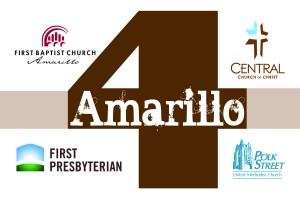
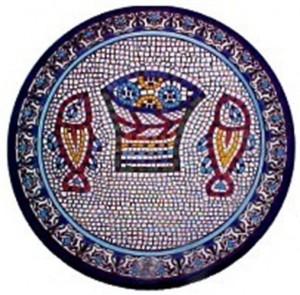
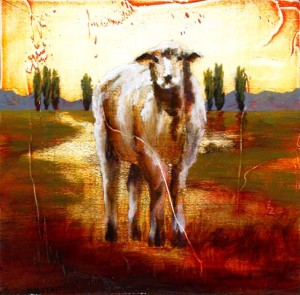
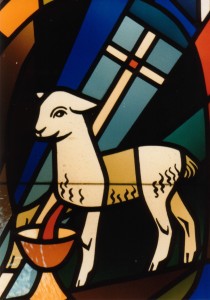

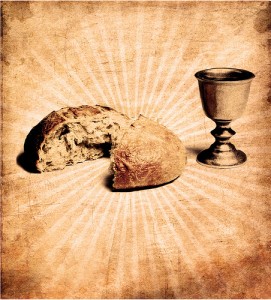
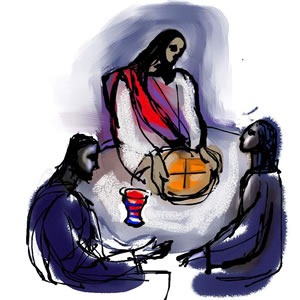




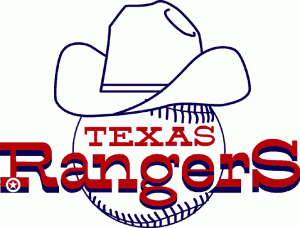

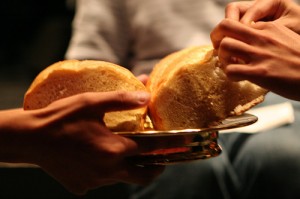
Recent Comments